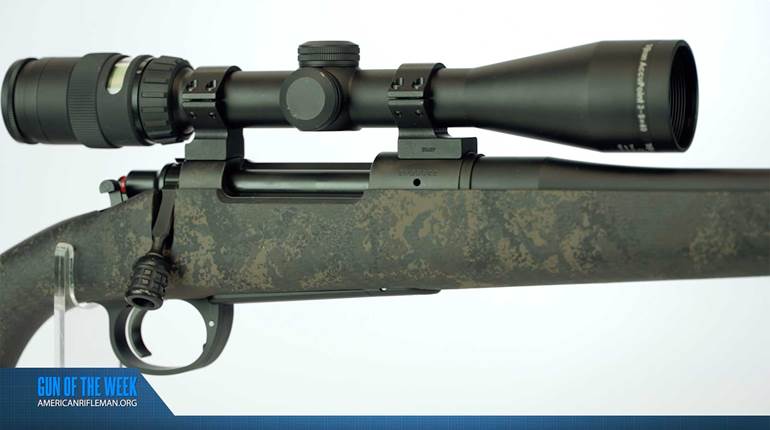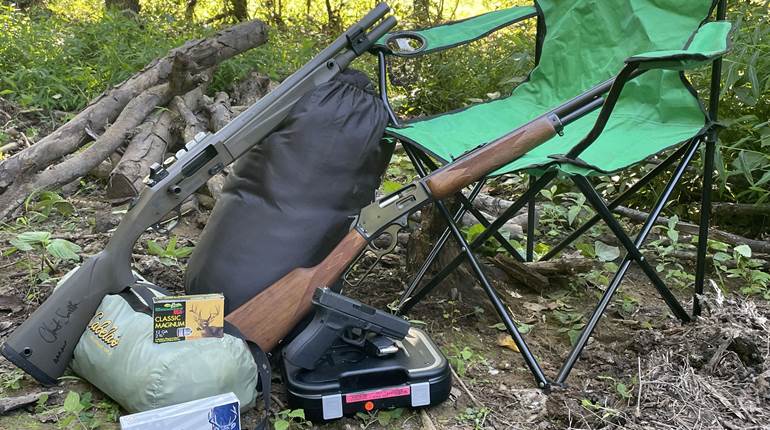
The 6.5x55 mm Swedish is an age-old cartridge, drafted for military duty by Sweden and Norway in 1894. The 6.5 mm Swede has also been rejuvenated in recent years due to interest in a host of popular new 6.5 mm cartridges and the stream of new bullets, initially intended for those cartridges, that make the now-classic Swede an even better target and hunting cartridge.

A full-metal-jacket, round-nose, 156-grain bullet was the original military load for the Swede. Decades later, the Swedish military updated to a 139-grain pointed bullet with a boattail. Streamlined bullets have been the trend ever since for the 6.5 mm Swede when shooting targets and game from fox to moose.
The Sauer 404 rifle used to shoot the 6.5 mm Swede cartridges listed in the load chart has a 1:8.66" rifling twist, which is fairly standard for Swede rifles. The Sauer accurately shot bullets as long as the Hornady 143-grain ELD-X, although Hornady recommends a minimum 1:8" twist for the bullet. Longer bullets like the Berger 156-grain Extreme Outer Limits Elite Hunter and Sierra 150-grain MatchKing probably require a faster twist than the Sauer’s. Other than those, the door is open to all manner of 6.5 mm bullets introduced in recent years, thanks to the popularity of the 6.5 mm Creedmoor.

The Creedmoor and Swede share the same concept of propellant fill and bullet-seating depth. A proper amount of propellant fills their cases close to the top of the shoulder. To keep from intruding into that propellant space, long bullets are seated with their base at the bottom of the case neck and their forward portion well out of the case mouth. For example, 45.5 grains of Hybrid 100V fills a 6.5x55 mm case up to just short of the bottom of the neck where the base of a Sierra 130-grain GameChanger bullet holds it firmly in place. That bullet-seating depth results in a cartridge length of 3.140", which places the bullet 0.040" short of contacting the rifling in the Sauer 404 barrel—a perfect fit.
Proper propellants for the 6.5 mm Swede are the same as, to a touch slower-burning than, those that would be used for 6.5 mm Creedmoor. H4350, Hybrid 100V and Reloder 22 are good choices, but keep N560 in mind. IMR 4831 and 4955 are excellent for speed and accuracy with all bullet weights.
Because of the variety of propellants and wide selection of bullet choices, the 6.5 mm Swede is one of the easiest cartridges to handload. Just about any combination produces even velocities and a good return in bullet speed for each grain of powder burned. Other such cartridges include the .250 Savage, .308 Win. and, yes, the 6.5 mm Creedmoor.

I had grand hunting plans for my first 6.5 mm Swede rifle. Instead, the rifle ended up in the hands of one young hunter after another. The new hunters practiced during the summer shooting at least several boxes of cartridges handloaded with lightweight bullets. Come fall, they enjoyed great success hunting antelope, deer and elk shooting 6.5 mm cartridges handloaded with bullets, from the Sierra 120-grain Pro-Hunter to Swift’s 140-grain A-Frame.
One of those young hunters was Sam Hall, who wanted an elk more than anything. He hiked the mountains at every opportunity with the 6.5 mm rifle in hand, but luck escaped him, while his cousin did shoot an elk. The next morning, Sam dutifully headed up the trail toward the elk in front of his dad and cousin leading pack horses. Sam walked around a bend in the trail and looked up the hill through a sift of falling snow and saw a cow elk staring down at him. He fired a Nosler 125-grain Partition, and the elk collapsed. It slid down the hill and piled up on the trail, just as his dad and cousin came around the bend in the trail.

Cartridge Comparisons
In addition to the 6.5x55 mm Swedish, the Sauer 404 is chambered in 15 other cartridges, from .243 Win. to 10.3x60 mm R Swiss. The 404’s barrel can be switched out, and, if required, so can the bolt head and magazine, in order to convert the rifle to any of these cartridges. But really, a rifle chambered in 6.5x55 mm firing 90- to 100-grain bullets eliminates the need for a .243 and shooting 130- to 160-grain bullets negates the necessity of .308 Win. and 6.5 mm Creedmoor.
 That’s because the Swede and the Creedmoor are ballistic peas in a pod. In fact, the Creedmoor case is basically the Swede case shortened by about 0.230" in the body, with most of the taper removed. The Creedmoor’s maximum average pressure is set at 62,000 p.s.i., while the Swede’s is 51,000 p.s.i. That modest pressure is in consideration for old rifles such as the Swedish Mauser Models 38, 94 and 96 and the Norwegian Krag-Jørgensen Models 1894 and 1912. As a result, American factory-loaded 6.5x55 mm cartridges fire 140-grain bullets at an advertised 2,550 f.p.s.
That’s because the Swede and the Creedmoor are ballistic peas in a pod. In fact, the Creedmoor case is basically the Swede case shortened by about 0.230" in the body, with most of the taper removed. The Creedmoor’s maximum average pressure is set at 62,000 p.s.i., while the Swede’s is 51,000 p.s.i. That modest pressure is in consideration for old rifles such as the Swedish Mauser Models 38, 94 and 96 and the Norwegian Krag-Jørgensen Models 1894 and 1912. As a result, American factory-loaded 6.5x55 mm cartridges fire 140-grain bullets at an advertised 2,550 f.p.s.
In Europe, however, some 6.5x55 mm Swedish cartridges are loaded to higher pressures. The cartridge’s name has been standardized as the 6.5x55 SE (Swedish) for countries that are members of the Permanent International Commission for the Proof of Small Arms (CIP). There is also 6.5x55 SKAN, which most likely stands for “Scandinavia,” used for the 6.5x55 SE by non-CIP member countries. Both cartridges are loaded to a maximum pressure of 55,114 p.s.i.

Handloading data for these higher-pressure loads are available from various sources. The Vihtavuori powder website (vihtavuori.com) lists load data for the 6.5x55 mm Swedish separately from 6.5x55 SE and SKAN. The reloading data contains the warning: “This reloading data is intended to use at (sic) modern rifles in good condition such as Sauer, Sako or Blaser chambered to 6,5 x 55 SKAN or 6,5 x 55 SE.” The Speer Handloading Manual Number 15 lists loads with relatively low pressures for military actions and separate higher-pressure loads for strong commercial actions. Loads in the Western Powders Handloading Guide Edition 1 also top out at 55,000 p.s.i.
Loaded to that higher pressure, the Swede and Creedmoor mirror each other’s velocities, and the Creedmoor’s emulation of the 127-year-old 6.5x55 mm is certainly the sincerest form of flattery.





































